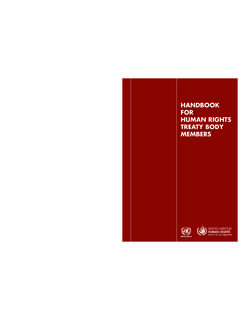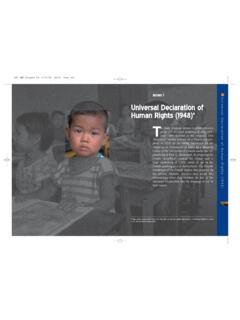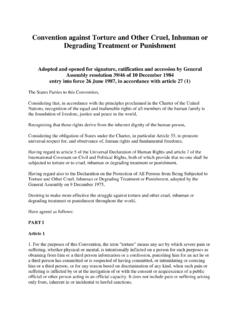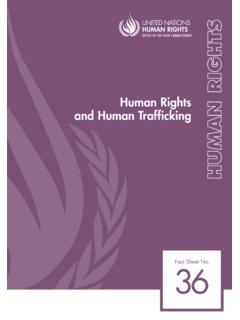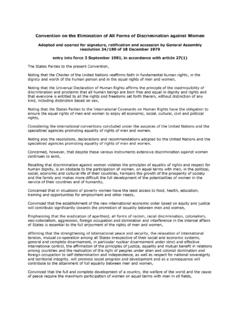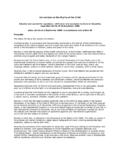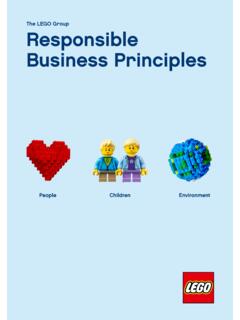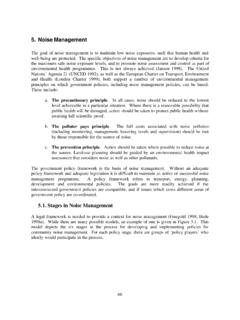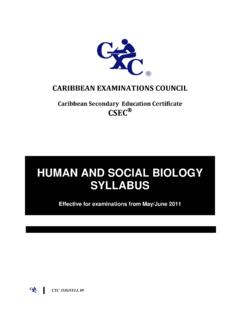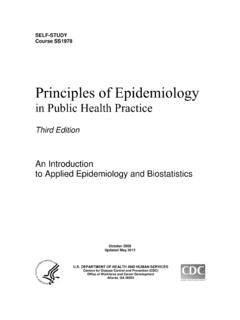Transcription of RECOMMENDED PRINCIPLES and GUIDELINES on HUMAN …
1 RECOMMENDEDPRINCIPLES and GUIDELINESon HUMAN RIGHTSINTERNATIONAL BORDERSatRECOMMENDED PRINCIPLES and GUIDELINES on HUMAN rights at international BORDERSF orewordOHCHR s RECOMMENDED PRINCIPLES and GUIDELINES on HUMAN rights at international Borders are the result of wide-ranging expert consultations to draw up normative GUIDELINES on the governance of international borders. They are intended to inform the work of States, international agencies and other stakeholders with an interest in HUMAN rights -based border governance. The PRINCIPLES and GUIDELINES accompanied the report of the Secretary-General on Protection of Migrants (A/69/277) presented to the 69th session of the General Assembly held in 2014. Member States have taken note of the PRINCIPLES and GUIDELINES in General Assembly resolutions on Protection of Migrants and on Migrant children and borders can be dangerous places for migrants, particularly those who are (or who are presumed to be) in irregular situations.
2 Many migrants lose their lives when they board unseaworthy boats, smugglers leave them to die at sea, or when border guards are given orders to shoot at sight to deter irregular migration. At land, sea and air borders around the world, migrants experience discrimination and arbitrary decision-making, unlawful profiling and disproportionate interference with the right to privacy, torture and sexual and gender-based violence, dangerous interception practices, and prolonged or arbitrary detention. National law and administrative regulations can also characterize borders as zones of exclusion or exception for HUMAN rights obligations, and seek to exempt them from compliance with the HUMAN rights safeguards, checks and balances that are usually embedded in national , and a range of other HUMAN rights issues, are addressed in OHCHR s RECOMMENDED PRINCIPLES and GUIDELINES on HUMAN rights at international Borders.
3 The fundamental premise of iithe PRINCIPLES and GUIDELINES is that international HUMAN rights law provides that all migrants, regardless of their legal status, how they arrive at the border , where they come from or what they look like, are entitled to enjoy their HUMAN rights . As their introduction makes clear, Underpinning these PRINCIPLES and GUIDELINES is the belief that respecting the HUMAN rights of all migrants, regardless of their nationality, migration status or other circumstances, facilitates effective border governance. I urge States, international and civil society organizations to make use of the PRINCIPLES and GUIDELINES in their border governance Ra ad Al Hussein United Nations High Commissioner for HUMAN RightsiiiRECOMMENDED PRINCIPLES AND GUIDELINES ON HUMAN rights AT international BORDERSRECOMMENDED PRINCIPLES AND GUIDELINES ON HUMAN rights AT international BORDERSP refaceOHCHR s RECOMMENDED PRINCIPLES and GUIDELINES on HUMAN rights at international Borders contains three RECOMMENDED PRINCIPLES , all of which are derived from international HUMAN rights law and establish the obligation of States to protect, respect and fulfil HUMAN rights of all migrants at international borders; A.
4 The primacy of HUMAN rights : HUMAN rights should be at the centre of all border governance Non-discrimination: Migrants should be protected against any form of discrimination at Assistance and protection from harm: States should consider the individual circumstances of all migrants at borders, and ensure effective protection and access to PRINCIPLES assert in particular that the best interests of the child shall be a primary consideration applicable to all children at international borders, regardless of their migration status or that of their ten RECOMMENDED GUIDELINES aim to assist States in practical ways to address such issues as building HUMAN rights capacity at borders, ensuring HUMAN rights in rescue and interception, screening, avoiding detention, and enabling HUMAN rights -based return or removal. Each Guideline addresses the important issue of accountability, recommending that independent monitoring mechanisms are set up at borders and that all migrants be able to access effective GUIDELINES provide a wealth of detail on the many, often complex, HUMAN rights issues implicated at international borders.
5 For example, in relation to the promotion and protection of HUMAN rights , Guideline One calls on States and other actors as relevant to utilise information campaigns and the media to protect migrants and challenge xenophobia at borders. It notes that the term illegal should not be used to refer to migrants in an irregular situation. Guideline Two on the legal and policy framework asks States to ensure that the irregular entry of migrants is not considered a criminal offence and ivthat acts of private individuals who rescue migrants in distress are not criminalised. It calls for appropriate sanctions for the excessive use of force, criminality and corruption at borders. In terms of building HUMAN rights capacity, Guideline Three calls for border authorities to be adequately trained, equipped and remunerated. States are asked to develop and adopt binding codes of conduct for border Four calls for the inclusion of HUMAN rights standards and safeguards in rescue and interception measures, and recommends such practical measures as providing rescue beacons along dangerous migration routes, and compensating shipmasters who incur financial losses for rescuing migrants.
6 The Guideline establishes the accountability of private transport companies that are involved in implementing entry restriction measures such as pre-departure screening. Guideline Five considers HUMAN rights requirements in the context of immediate assistance such as medical care, adequate food and water, blankets, clothing, sanitary items and opportunity to rest. It calls on States to ensure that all migrants receive necessary medical attention including mental health referrals where the context of screening and interviewing, Guideline Six asserts that screening processes should uphold the right to privacy including in relation to searches and appropriate handling of property, and calls for rigorous safeguards in the collection of data at borders (particularly biometric data). All entry restrictions should be HUMAN - rights compliant, and there should be no compulsory testing for conditions such as HIV, tuberculosis and pregnancy as part of migration policy.
7 The Guideline calls on States to pay particular attention to the situation of women (while also ensuring that border authorities do not presume women to be vulnerable or to lack agency), migrants with disabilities, LGBTI migrants and children in screening and interviewing Seven refers to identification and referral and encourages States to develop practical GUIDELINES and standardized procedures in this regard, calling also for relevant service providers to be present at borders. The Guideline asserts vRECOMMENDED PRINCIPLES AND GUIDELINES ON HUMAN rights AT international BORDERS that children should be promptly identified and that anyone claiming to be a child should be treated as such and given access to proper age determination processes. Also, survivors of torture, violence and trauma should be referred to medical and psycho-social services, and any measures taken at borders should avoid are asked in Guideline Eight to amend legislation to establish a presumption against detention in law, and to legally prescribe HUMAN rights -compliant alternatives to detention.
8 Where detention is found to be necessary, conditions in detention facilities where migrants are detained should be in line with international standards, and there should be independent monitoring and evaluation at such places, including by national preventive mechanisms. Where appropriate, migrants in detention should be enabled to make contact with their consular authorities as well as relevant HUMAN rights Nine states that returns or removals should not violate the principle of non-refoulement and/or the prohibition of collective expulsion. It notes in particular that any consent given to voluntary return processes should be free of any coercion, such as the threats or the prospect of indefinite detention. Migrants should not be returned to situations of destitution or inhospitable conditions where their safety or HUMAN rights are threatened, such as through deportation to so-called no-man s land between borders.
9 In the case of forced returns, the Guideline calls on States to ensure that return procedures are not carried out at all costs, but are interrupted where the HUMAN rights of the migrant are compromised, and that migrants whose rights are violated during return processes can file , Guideline Ten on cooperation and coordination asks States to include explicit HUMAN rights guarantees in operational agreements and arrangements and to immediately suspend any cooperation arrangements, such as ship-rider agreements, joint patrols or data-sharing agreements that are not in accordance with international HUMAN rights law and standards. It notes that States should cooperate across borders to promote HUMAN rights -based, equitable, dignified, lawful and evidence-based migration and border governance Paragraphs Page Foreword ii Preface ivI.
10 INTRODUCTION1 101 A. HUMAN rights at international borders1 41 B. Scope and Purpose of the PRINCIPLES and Guidelines5 103II. RECOMMENDED PRINCIPLES ON HUMAN rights AT international BORDERS1 137 A. The primacy of HUMAN rights1 77 B. Non-discrimination8 98 C. assistance and protection from harm10 139 III. RECOMMENDED GUIDELINES ON HUMAN rights AT international BORDERS11 Guideline 1: Promotion and protection of HUMAN rights1 1011 Guideline 2: Legal and policy framework1 1314 Guideline 3: Building HUMAN rights capacity1 1917 Guideline 4: Ensuring HUMAN rights in rescue and interception1 1621 Guideline 5: HUMAN rights in the context of immediate assistance1 925 Guideline 6: Screening and interviewing1 1827 Guideline 7: Identification and referral1 1131 Guideline 8: Avoiding detention1 2033 Guideline 9: HUMAN rights -based return or removal1 2237 Guideline 10: Cooperation and coordination1 1242viiRECOMMENDED PRINCIPLES AND GUIDELINES ON HUMAN rights AT international BORDERS UN Photo/Sylvain LiechtI.


